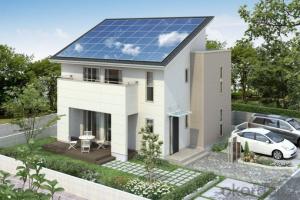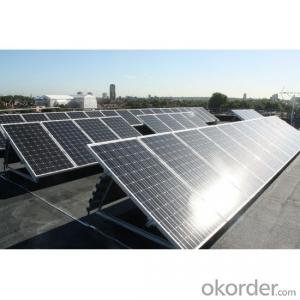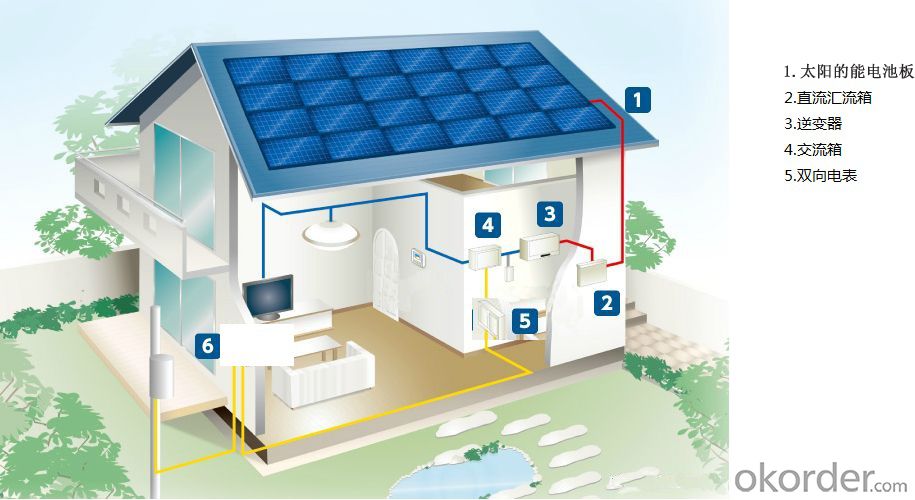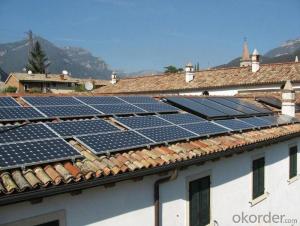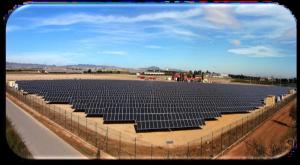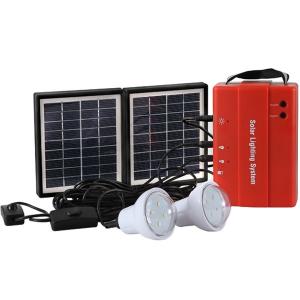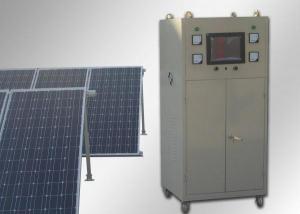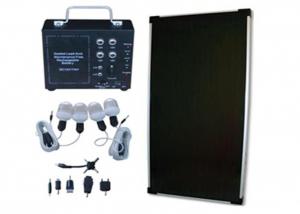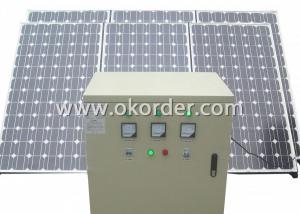Roof and Ground Solar System Falsh Sale New
- Loading Port:
- Shanghai
- Payment Terms:
- TT or LC
- Min Order Qty:
- 2000 watt
- Supply Capability:
- 2000000 watt/month
OKorder Service Pledge
OKorder Financial Service
You Might Also Like
| Quick Details | |||||
| Specification: | Normal | Application: | Home | Output Voltage (V): | AC110V/220V |
| Load Power (W): | 3KW | Solar Power (W): | 3KW | Work Time (h): | 48 |
| Cables: | 50m | Solar Panel Rack: | Optional | Battery Capacity: | 12V/200AH*8pcs |
| Controller Voltage: | 48V | Inverter Output Voltage: | AC220V/110V | Efficiency: | 90% |
| Inverter: | DC48V | Rated Output Capacity: | 3000W | Solar Panel Power: | 250w*12pcs |
| Solar Panel Type: | Crystalline Silicon PV Module | ||||
| Packaging & Delivery | |
| Packaging Detail: | using carton or wooden box as per customer's requirement. |
| Delivery Detail: | within 10~30 days for shipment depending on order quantity |
Excellent battery backup 300W to 10KW off grid solar system with grid power switch
Anern Advantage:
1) Over 10 year experience in clean energy line, business covering solar street light, solar garden light, off grid
solar system and on grid solar power system, etc;
2) Exporting for worldwide, with satisfied clients more than 50 countries;
3) Competitive price, excellent service, integrated certificate system;
We supply CE, RoHS certificates if you need
Welcome to visit our factory at any time.
Solar system advantages:
1. CE, ROHS approved.
2. High conversion efficiency, high-transmission rate.
3. Energy saving, environmental-friendly.
4. Advanced technology, strict quality control system.
5. Easy installation, safe operation, free maintenance.
6. Low MOQ, fast delivery time, long service life
| Specifications: | ||
| Ref No. | OFF-SGHP-3KW | |
| System Basic Information | Solar Panel Rated Output Power | 3KW |
| Suitable for Max Daily Power Consumption | 10KWH | |
| Rated Output AC Capacity | 3KW | |
| Solar panel | ||
| Type | Crystalline Silicon PV Module, A-class | 12pcs |
| Max Power | 250W | |
| Vmp | 30.5V | |
| Size | 1655*992*45mm | |
| Weight | 22.5kg/pc | |
| 25 years power output guarantee (Note: 2pcs panels connect in series) | ||
| Controller | ||
| Voltage | 48V | 1pc |
| Current | 60A | |
| Warranty | 1 year | |
| PWM high-efficiency charging controller, LED display, intelligent control; Temperature compensation, various protections. | ||
| Circuit Breaker | Used for protection of controller, installed between PV array combiner and controller | 1pc |
| Inverter | ||
| Input Voltage | DC48V | 1set |
| Output Voltage | AC220V/110V 1-phase | |
| Frequency | 50/60Hz | |
| Efficiency | 90% | |
| Note: This inverter provides grid power switch and battery charging functions. | ||
| Battery | ||
| Capacities | 12V/200AH per piece | 8pcs |
| Service life | 5 to 6 years | |
| Warranty | 3 years | |
| Solar panel rack | Flat-roof type mounting rack, steel material, anti-rust treatment | 1 set |
| (Other types of racks can be customized as per client's requirement) | ||
| Cable | 50m | |
| Connectors | 3-terminal connectors, used for panels connection in parallel | 6 set |
Product features:
1. Off grid solar power system is mainly used for application with relatively-small power consumption, and the areas have no grid network coverage, or grid power is unstable or outage condition.
2. It’s composed of solar panels, hybrid solar inverter, battery bank, solar panel mounting racks, and other accessories required fora complete home solar power system.
3. The battery bank gives a stable power output to the solar inverter which converts DC to AC to power loads, and provides power backup in rainy or cloudy days.
4. The solar panels generate electricity at daytime and charge the battery bank .
5. The off grid home solar power system provides grid power bypass in case of battery power shortage when sunshine is not enough.
6. All the off grid home solar power system configurations are worked out by scientific calculation and design.
FAQ
We have organized several common questions for our clients,may help you sincerely:
1.How about your company?
We are a private-owned high-tech company who specializes in developing, manufacturing and marketing of silicon ingots, solar wafer, solar cells, solar modules, PV systems and solar applications products.
At present, We has one research & development team, whose members are well-known experts in photovoltaic area. We also have advanced production and test equipment.
2.How to guarantee the quality of the products?
Our products have been certified by CE, CEC,MCS, IEC61215, IEC61
730 and ISO9001.
• 25 year transferrable power output warranty: 10 years / 90%, 25 years / 80%*
• 12 year material and workmanship warranty
• Timeliness of delivery
• Quality Products certified (TUV, IEC, CE.ISO9001.MCS)
3.How long can we receive the product after purchase?
In the purchase of product within three working days, We will arrange the factory delivery as soon as possible. The pecific time of receiving is
- Q: Can solar energy systems be used in areas with limited access to solar fuses and breakers?
- Yes, solar energy systems can still be used in areas with limited access to solar fuses and breakers. While fuses and breakers are important components for safety and protection in a solar energy system, there are alternative methods available to ensure the system operates safely. These can include using surge protectors, isolators, and other protective devices to prevent overloads and short circuits. Additionally, proper installation, regular maintenance, and adherence to safety guidelines can help mitigate risks even in areas with limited access to solar fuses and breakers.
- Q: Can solar energy be used during power outages?
- Indeed, the utilization of solar energy is possible in situations of power outages. Solar panels, also referred to as photovoltaic (PV) systems, have the capability to convert sunlight into electricity. By connecting these panels to a storage battery system, any surplus solar energy can be stored and utilized when sunlight is not accessible, such as during power failures. These battery systems serve as dependable sources of electricity, ensuring the continuity of essential appliances and devices even when the main power supply is disrupted. Furthermore, solar-powered generators can also be employed temporarily during power outages to provide an alternative source of electricity. In summary, solar energy systems present a trustworthy and sustainable solution to power outages, enabling the provision of electricity even in instances of traditional power grid failures.
- Q: How does the angle of solar panels affect their efficiency?
- The angle of solar panels significantly affects their efficiency. By adjusting the angle, panels can maximize their exposure to sunlight, ensuring optimal energy absorption. The ideal angle varies depending on the geographical location, time of year, and panel type. A properly adjusted angle can increase the efficiency of solar panels and ultimately enhance their electricity generation.
- Q: Can solar energy systems be used in areas with high levels of dust or sandstorms?
- Yes, solar energy systems can be used in areas with high levels of dust or sandstorms. While dust and sandstorms can temporarily reduce the efficiency of solar panels by blocking sunlight, there are several measures that can be taken to mitigate their impact. Firstly, regular cleaning and maintenance of solar panels can help to remove accumulated dust and debris, ensuring maximum sunlight absorption. This can be done manually or through automated cleaning systems that use water or brushes to keep the panels clean. Secondly, advanced panel designs and coatings are available that can minimize the adhesion of dust particles and facilitate easy cleaning. These technologies can help panels to self-clean or reduce the accumulation of dust, ensuring optimal performance even in dusty environments. Additionally, proper installation and positioning of solar panels can also play a significant role in reducing the impact of dust or sandstorms. By tilting the panels at an appropriate angle and maintaining a sufficient ground clearance, the accumulation of dust can be minimized. Furthermore, the use of protective measures such as fences, windbreakers, or enclosures around the solar energy systems can help shield the panels from strong winds and blowing sand during sandstorms. These measures can help prevent physical damage to the panels and maintain their functionality. In conclusion, while dust or sandstorms can pose temporary challenges to solar energy systems, with proper maintenance, cleaning, panel design, positioning, and protective measures, solar energy can still be effectively harnessed in areas with high levels of dust or sandstorms.
- Q: Can solar energy systems be used for heating and cooling homes?
- Yes, solar energy systems can be used for heating and cooling homes. Solar thermal systems can capture the sun's heat and use it to provide hot water or space heating. Additionally, solar-powered air conditioning systems can use solar energy to cool homes by absorbing heat from the indoor air and dissipating it outside.
- Q: Can solar energy systems be used in powering car charging stations?
- Car charging stations can definitely be powered by solar energy systems. Actually, many car charging stations worldwide already rely on solar energy. Solar panels can be placed on the roof or in close proximity to the charging station, capturing sunlight and converting it into electricity. This renewable energy can then be used to charge electric vehicles (EVs) without depending on the traditional power grid. Solar-powered car charging stations have several advantages. Firstly, they provide a sustainable and clean energy source, reducing carbon emissions and the overall environmental impact of EVs. Secondly, they can be installed in remote or off-grid areas where connecting to the electrical grid may be difficult or costly. This makes solar-powered charging stations especially beneficial for rural regions or highways lacking easy access to electricity. Additionally, solar energy systems can incorporate battery storage, enabling excess energy generated during the day to be stored and utilized during the night or periods of high demand. This guarantees a continuous and reliable power source for car charging stations, even in the absence of sunlight. Although the initial installation cost of solar energy systems may be higher when compared to traditional power sources, their long-term operating and maintenance costs are generally lower. Moreover, there are various government incentives and rebates available to promote the use of renewable energy, which can help offset these initial expenses. All in all, solar energy systems offer a viable and sustainable solution for powering car charging stations, providing environmental benefits, energy independence, and long-term cost savings.
- Q: Can solar energy systems be used in powering airports or transportation hubs?
- Yes, solar energy systems can be used to power airports or transportation hubs. In fact, many airports around the world are already using solar energy to offset their energy consumption and reduce their carbon footprint. Solar panels can be installed on rooftops, parking lots, or unused land at airports to generate electricity that can be used to power various operations, such as lighting, heating, cooling, and even charging electric vehicles. This helps airports become more sustainable and reduce their dependence on fossil fuels.
- Q: Solar power generation system suitable for home, how much is the cost of a set?
- The use of solar power system has many parts, have the power of this parameter, he said 500W1000W is a parameter which kind of accessories, and electricity related degree is large, panels, solar power systems, accessories, solar panels for electricity generating capacity of the inverter board and the two parts of the largest correlation under normal circumstances, the board 1000W day power of 4
- Q: Can solar energy be used to power my entire home?
- Your entire home can be powered by solar energy. Photovoltaic (PV) panels, also known as solar panels, convert sunlight into electricity. This electricity can then be used to power all the electrical appliances and systems in your home. If you install an adequate number of solar panels on your roof or in your yard, you can generate enough electricity to meet your household's energy requirements. However, the amount of solar energy your home can produce depends on various factors such as the size and orientation of your roof, the amount of sunlight in your area, and your energy consumption habits. To ensure that solar energy can power your entire home, you may need to install a battery storage system. This system will store any excess energy generated during the day for use at night or on cloudy days. Additionally, to maximize the benefits of solar energy and reduce reliance on the grid, you should make energy-efficient choices and decrease your overall energy consumption.
- Q: How much sunlight is needed for a solar energy system to be effective?
- A solar energy system can be effective with as little as 5 hours of direct sunlight per day, although the ideal range is typically 6 to 8 hours.
Send your message to us
Roof and Ground Solar System Falsh Sale New
- Loading Port:
- Shanghai
- Payment Terms:
- TT or LC
- Min Order Qty:
- 2000 watt
- Supply Capability:
- 2000000 watt/month
OKorder Service Pledge
OKorder Financial Service
Similar products
Hot products
Hot Searches
Related keywords
